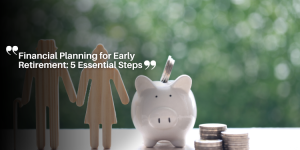Retirement planning with diversified portfolios: a smart strategy

Effective retirement planning with diversified portfolios involves starting early, maximizing employer matches, maintaining a balanced mix of investments, and regularly reviewing your strategies to ensure financial security in your later years.
Retirement planning with diversified portfolios can be daunting, but it doesn’t have to be. Have you ever thought about how your choices today can impact your financial security tomorrow? Let’s dive into some strategies that can help you make informed decisions.
Understanding diversified portfolios for retirement
When it comes to understanding diversified portfolios for retirement, it’s essential to grasp the basic principles of investing. A diversified portfolio is like a well-balanced meal; it includes a variety of assets to minimize risks and enhance potential returns.
What is Diversification?
Diversification involves spreading investments across different assets, such as stocks, bonds, and real estate. By doing this, you can reduce the impact of any single investment’s poor performance on your overall portfolio.
Benefits of a Diversified Portfolio
- Risk reduction: By balancing various asset classes, you decrease the risk of severe losses.
- Potential for higher returns: A well-structured portfolio might lead to better long-term gains.
- Adaptability: Diversification allows your investments to adapt to different market conditions.
Incorporating a mix of assets also helps you to align your portfolio with your personal retirement goals. For example, younger investors often choose higher-risk assets for potential growth, while those closer to retirement may prefer safer investments to preserve capital.
Moreover, regularly reviewing your portfolio is crucial. Market conditions change, and so do your financial needs. By adjusting your allocations, you ensure that your portfolio continues to smoothly provide for your retirement.
Aiming for diversification means you are preparing for future uncertainties, letting your investments work together rather than against each other. Remember, a successful retirement is built on smart choices today that pave the way for a secure tomorrow.
Benefits of diversification in retirement planning
The benefits of diversification in retirement planning are immense and can significantly impact your financial future. By diversifying your investments, you are not only protecting your assets but also enhancing their potential growth.
Risk Management
Diversification is a key strategy in managing investment risk. When you spread your assets across various investments, such as stocks, bonds, and real estate, the impact of any poor performance is minimized. This means that if one investment does poorly, others may perform well, offering a cushion against total losses.
Enhanced Returns
Another advantage is the potential for enhanced returns. A diversified portfolio allows you to take advantage of different market opportunities. For instance, while stocks may grow over a longer time frame, bonds can provide steady income, making your portfolio more resilient.
- Better growth potential: Different assets can grow at various rates.
- Income stability: Bonds can provide regular interest income.
- Access to various markets: Investing globally can expose you to new opportunities.
Moreover, diversification can lead to a smoother ride in your investment journey. Investing can be unpredictable, and having a range of assets helps buffer against the volatility of the markets. When one asset class dips, others may remain stable or even increase in value.
Incorporating a diversified approach in your retirement planning means you are paving the way for a more secure financial future. By regularly reviewing and adjusting your portfolio, you can ensure that it aligns with your evolving retirement goals.

How to build a solid retirement portfolio
Building a solid retirement portfolio is essential for ensuring financial security in your golden years. A well-structured portfolio can help you face uncertainties and provide a comfortable lifestyle after retirement.
Determine Your Retirement Goals
Start by identifying your retirement objectives. Consider when you plan to retire, your desired lifestyle, and the expenses you anticipate. This understanding will guide your investment choices.
Choose a Suitable Asset Allocation
Your asset allocation is how you spread your investments across different asset classes. A good rule of thumb is to have a mix of stocks, bonds, and cash or cash equivalents. Younger investors may opt for a more aggressive approach, favoring stocks for growth, while those closer to retirement might shift towards bonds for stability.
- Growth assets: Stocks, real estate, and mutual funds.
- Income-generating assets: Bonds, dividend stocks, and fixed annuities.
- Preservation assets: Cash, treasury bills, and certificates of deposit.
It’s vital to regularly review your asset allocation. As you age and your risk tolerance changes, adjust your investments accordingly to ensure your portfolio aligns with your retirement goals.
Additionally, consider diversifying within each asset class. This means selecting various investments within stocks, bonds, and cash to mitigate risks further. For example, in the stock category, you might include growth stocks, value stocks, and international stocks.
Another key element is to keep an eye on investment fees. High fees can erode your returns, especially over time. Opting for low-cost index funds can be a smart decision.
Common mistakes in retirement planning
Avoiding common mistakes in retirement planning is crucial for ensuring a secure financial future. Many people overlook key aspects that can hinder their retirement savings. Being aware of these pitfalls can help you stay on track.
Not Starting Early Enough
One of the biggest mistakes is delaying retirement savings. The sooner you start investing, the more time your money has to grow through compound interest. Even small contributions can add up over time, so it’s important to start as early as possible.
Ignoring Employer Matches
If your employer offers a retirement plan with a matching contribution, not taking full advantage of it is a missed opportunity. This match is essentially free money, helping you boost your savings significantly. Make sure to contribute enough to get the full match.
- Contribute at least enough: Aim for the maximum match your employer offers.
- Review your contributions: Adjust them as your salary increases.
- Understand your plan: Familiarize yourself with the details of your employer’s retirement benefits.
Another common mistake is not diversifying investments within your retirement portfolio. Keeping all your money in one type of investment can expose you to greater risks. A diversified portfolio can provide better stability and growth potential. Ensure you include a mix of asset classes like stocks, bonds, and cash equivalents.
Additionally, failing to regularly review and adjust your retirement plans can lead to outdated strategies that no longer fit your goals or risk tolerance. Life changes such as marriage, having children, or changing jobs can affect your retirement needs. Keep your plan aligned with your current situation.
In conclusion, successful retirement planning requires awareness and proactive strategies. By avoiding common mistakes, starting early, and diversifying your investments, you can build a solid financial foundation for your future. Regularly reviewing and adjusting your retirement plan will help ensure it aligns with your goals and adapts to life’s changes. Remember, every step you take today can lead to a more secure and enjoyable retirement tomorrow. Stay informed and make smart choices about your financial future.
FAQ – Common Questions About Retirement Planning
What is the best age to start planning for retirement?
The earlier you start planning for retirement, the better. Ideally, you should begin as soon as you start your first job to take advantage of compound interest.
How can I maximize my retirement savings?
To maximize your savings, contribute enough to get any employer match, diversify your investments, and regularly review your portfolio.
What types of investments should I include in my retirement portfolio?
A solid retirement portfolio should include a mix of stocks, bonds, and real estate to ensure growth and reduce risk.
How often should I review my retirement plan?
You should review your retirement plan at least once a year, or whenever there are significant life changes such as a new job or family situation.







